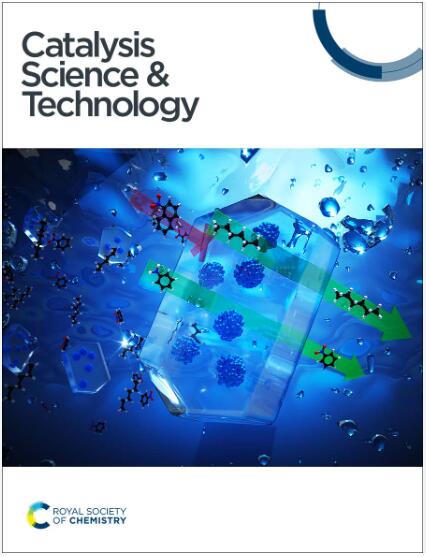Activity enhancement of Ru/TiO2 catalysts for catalytic hydrogenation of amides to amines through controlling strong metal–support interactions†
IF 4.2
3区 化学
Q2 CHEMISTRY, PHYSICAL
引用次数: 0
Abstract
Efficient and selective catalytic hydrogenation of amides to amines is highly significant but extremely challenging. Here, a series of Ru/TiO2 catalysts were prepared with the impregnation method at different calcination and reduction temperatures. Multiple characterization tools were used to characterize the physicochemical properties of the catalysts. The hydrogenation of butyramide to butylamine as a model reaction was used to evaluate the catalytic performance. The catalytic activity of the Ru catalyst supported on rutile TiO2 was superior to that on anatase TiO2. As the calcination temperature increased from 200 °C to 600 °C, the catalytic performance of Ru/rutile catalysts monotonously decreased. With the reduction temperature increasing from 200 °C to 600 °C, Ru/rutile catalysts displayed a volcano-like trend of catalytic activity. The Ru/rutile catalyst calcined at 200 °C and reduced at 500 °C exhibited the highest catalytic performance, with 93% butyramide conversion and 65% selectivity to butylamine at 150 °C with 5 MPa H2. The evaluation and characterization results suggested that the lattice match between RuO2 and rutile TiO2 prevented Ru particle aggregation under high-temperature calcination, and smaller Ru particles were in favor of the amide hydrogenation reaction. The coverage of the TiOx overlayer on Ru nanoparticles and the Ru–TiOx boundary perimeter were effectively modulated by the strong metal–support interaction under different catalyst reduction temperatures, resulting in the optimization of the amide hydrogenation reactivity over Ru/rutile catalysts. This study facilitates the understanding of the influence of strong metal–support interaction on the catalytic hydrogenation of amide.
通过控制强金属-载体相互作用增强Ru/TiO2催化剂酰胺加氢制胺活性
高效、选择性的酰胺催化加氢制胺具有重要意义,但也极具挑战性。在不同的焙烧和还原温度下,采用浸渍法制备了一系列Ru/TiO2催化剂。采用多种表征工具对催化剂的理化性质进行了表征。以丁酰胺加氢制丁胺为模型反应,评价了催化性能。负载在金红石型TiO2上的Ru催化剂的催化活性优于负载在锐钛型TiO2上的Ru催化剂。随着煅烧温度从200℃升高到600℃,钌/金红石催化剂的催化性能单调下降。随着还原温度从200℃升高到600℃,Ru/金红石催化剂的催化活性呈现火山状趋势。Ru/金红石催化剂在200℃煅烧、500℃还原时表现出最高的催化性能,在150℃、5 MPa H2条件下,丁胺转化率为93%,丁胺选择性为65%。评价和表征结果表明,RuO2与金红石型TiO2之间的晶格匹配阻止了高温煅烧过程中Ru颗粒的聚集,较小的Ru颗粒有利于酰胺加氢反应。在不同的催化剂还原温度下,强金属-载体相互作用有效地调节了TiOx覆盖层在Ru纳米颗粒上的覆盖范围和Ru - TiOx边界周长,从而优化了Ru/金红石催化剂上的酰胺加氢反应活性。本研究有助于理解强金属-载体相互作用对酰胺催化加氢反应的影响。
本文章由计算机程序翻译,如有差异,请以英文原文为准。
求助全文
约1分钟内获得全文
求助全文
来源期刊

Catalysis Science & Technology
CHEMISTRY, PHYSICAL-
CiteScore
8.70
自引率
6.00%
发文量
587
审稿时长
1.5 months
期刊介绍:
A multidisciplinary journal focusing on cutting edge research across all fundamental science and technological aspects of catalysis.
Editor-in-chief: Bert Weckhuysen
Impact factor: 5.0
Time to first decision (peer reviewed only): 31 days
 求助内容:
求助内容: 应助结果提醒方式:
应助结果提醒方式:


